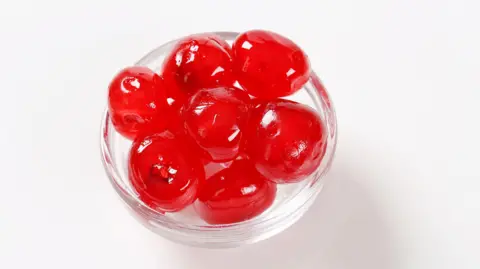 Getty Images
Getty ImagesThe United States has banned the use of synthetic dyes commonly added to food and drinks to give them their bright cherry red hue.
The U.S. Food and Drug Administration (FDA) announced Wednesday that manufacturers will no longer be allowed to use the dye, called Red No. 3, or Red Dye 3, after studies linked the dye to cancer in male lab rats. of dyes.
While normal human exposure to the dye is much lower than that of the mice in the study, U.S. law requires it to be banned if any link to cancer is found.
The dye is used primarily in candies, cakes, cookies, frozen desserts and frostings, as well as some pharmaceuticals, the agency said.
The ban is the result of a petition filed in 2022 by several groups, including the Center for Science in the Public Interest. They believe the dye should be banned because of its links to cancer and because it is widely used by American consumers, especially children.
The FDA banned Red No. 3 cosmetics 35 years ago. California also banned the additive in food in October 2023.
It is restricted in countries outside the United States, such as Australia, New Zealand, and the European Union.
The Center for Science in the Public Interest said the FDA ban was "long-delayed." The center, a U.S.-based nonprofit consumer rights group, has long pushed for the ban.
"The FDA has finally put an end to the regulatory paradox of Red 3 being illegal for use in lipstick, but perfectly legal when fed to children in candy form," Dr. Peter Lurie, the organization's president, said in a statement Wednesday.
Food manufacturers using Red 3 will have until January 2027 to reformulate their products, while drug manufacturers will have an extra year (until January 2028) to make adjustments.
Food imported into the United States must also comply with the new ban, the FDA said.
Which foods contain red dye 3?
Red No 3, also known as erythrosine or red dye 3, has been used in a variety of confectionery, baked goods, fruit products and beverages.
Colorful candies (such as Pez) contain additives as ingredients. It is also used in toaster pastries, maraschino cherries, and some sodas and fruity drinks.
This additive is used in cough syrups and gummy vitamins to give them their bright red color.
Some manufacturers have already phased out the use of the dye in their products, such as Dole, which phased it out of its fruit bowls in 2023.
Some companies have begun using red dye 40 instead of red dye 3 , which is considered a healthier alternative, although one study linked it to an increase in intestinal disease in mice.
Another study by the UK Food Standards Agency linked red dye 40 to an increase in ADHD in children. The additive has been banned in California schools since last year.
